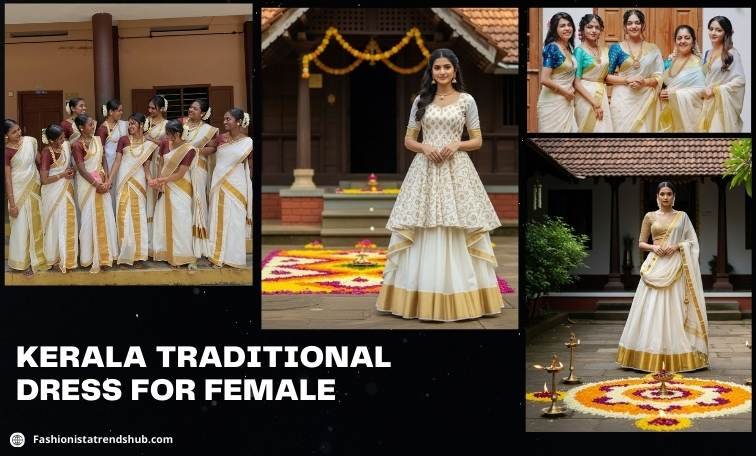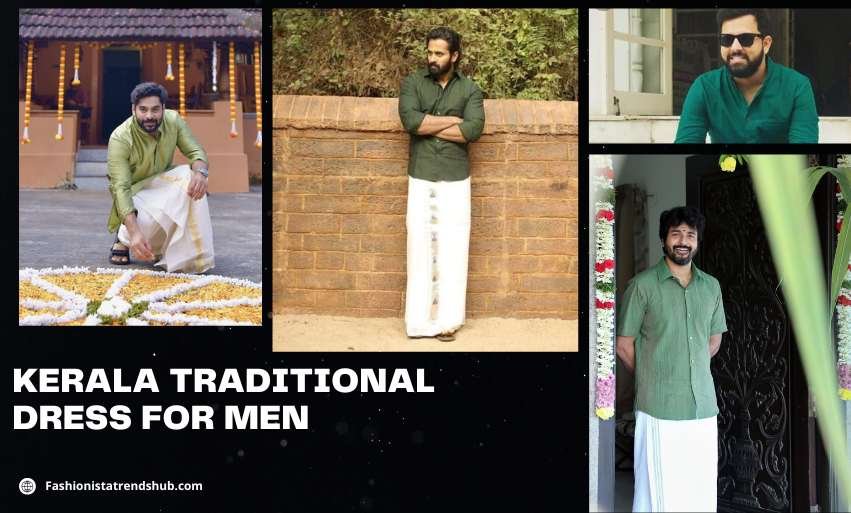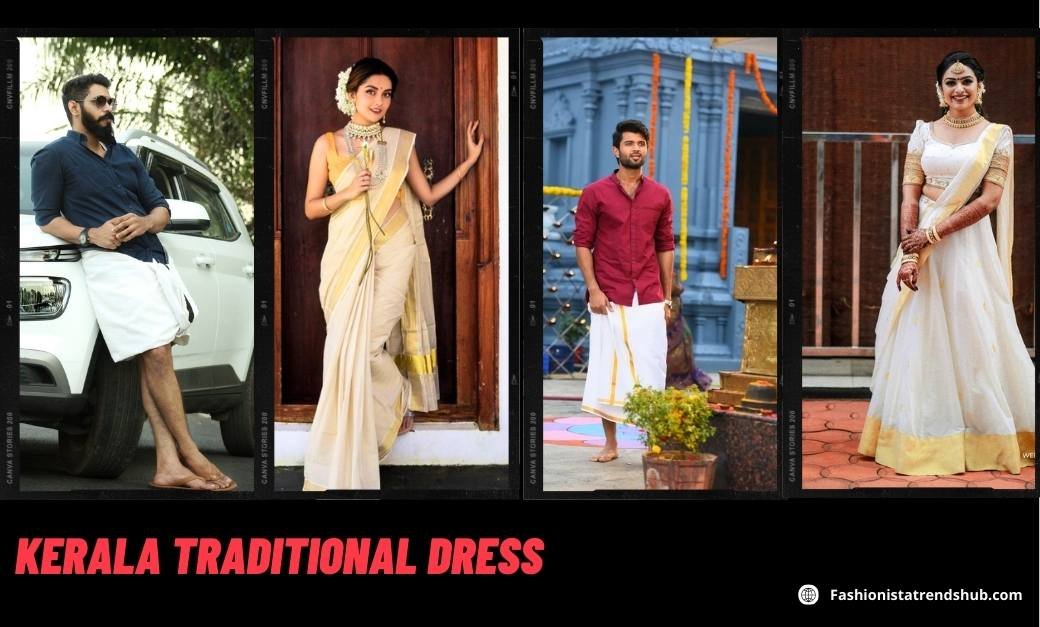Kerala traditional dress never fails to make an impression with its simplicity and cultural background. Famous for its iconic white and gold design, the livery imagery represents purity and prosperity, central to Kerala’s identity. Each piece has long-time traditions and artisanship behind it, as well as symbolic significance. Kasavu fabric, the kind that is hand-woven and used in traditional wear. It takes its pride from being an indispensable material during festivals such as Onam and Vishu. And the most famous wears – Mundu and Mundum Neriyathum – became a perennial cultural encapsulation. In this article, we will touch upon everything you need to know about the ethnic wear of Kerala, so let’s begin.
Kerala Traditional Dress for Women

The traditional dress of Kerala woman is epitomized by the Mundum Neriyathum, which is a two-piece attire that was considered the forerunner to the current sarees:
- Mundu: The lower garment worn to the waist and falls down to the ankle. Usually woven with fine cotton with a golden Kasavu border.
- Neriyathum: The upper garment worn on the shoulder, also called ‘Neriathu’, to add elegance and decorum to mundu.
The simplicity of the dress is enhanced by finely woven golden borders, which signify merriment and grace. Traditionally preferred by Hindu women, and commonly worn by Nair and Namboothiri women, this style is at its most lustrous on special occasions. The Mundum Neriyathum is part of the traditional dance form, like Mohiniyattam, and temple festivals.
Kerala Traditional Dress for Men

The Kerala traditional dress male is essentially the Mundu, an unstitched garment which is made to be wrapped around the waist. It is usually white with gold or colorful borders. The body is covered above the waist by a Melmundu or Mundum Neryathum, which is either tucked inside the shalya or worn over a large jacket. Characteristics include:
- It is the comfort factor for Kerala’s humid weather, along with cultural identity, that makes mundu so versatile.
- Melmundu is a male attire worn by men as part of religious rituals and festivals.
- Styles range from very traditional to the most contemporary, with some men wearing a Mundu with shirts such as those worn in the West.
Variations are influenced by community customs, such as that the Melmundu is worn for pujas for Namboothiri men, but they use Mundu all the time in everyday life.
Diversity of Traditional Dress of Kerala
Each community adapts Kerala’s core textile heritage to its own customs while maintaining the overall aesthetic of minimalism and elegance. Kerala has a diverse and multicultural population, so the dresses also vary in accordance with their social structure:
- Christian Women: Chatta Mundu with blouse and pleated mundu, commonly with the adornment of special tassels Njori.
- Muslim Communities: Men wear Mundus with colorful borders. Ladies are more inclined towards embroidered sarees with beautiful dupattas to cover up.
- Tribal Groups: They keep their original traditional totems and color matching their culture.
Every group interprets the textile heritage at the heart of Kerala in a way that suits their traditions while preserving the overall aesthetic of simplicity and grace.
Origin of Kasavu and Weaving Tradition
Kasavu, the golden zari border cloth adorning mundus and sarees, is integral to Kerala’s traditional costume. Crafted in weaving centers such as Balaramapuram, Chendamangalam, or Kuthampully, Kasavu is the product of intricate handloom techniques handed down through centuries. The silk threads employed here create a shimmer that sets ceremonial and ornate attire apart from workaday clothes. These weaving practices continue ancestral methods that have been transmitted through generations, thus confirming Kerala as a hotbed of fine textile art.
Social & Historical Significance of Kerala Dress
It’s not merely just an attire; it’s a history of the social and cultural transformation of Kerala. The Melmundu Samaram (Uppercloth Revolt) in 1859 was an early opposition to limits imposed by caste on dress. Before it, lower caste women were not allowed to wear the upper cloth in public, which represented oppressive social hierarchies. This rebellion on the part of social reformers influenced and encouraged egalitarian modes of dress. Kerala’s traditional dress today is a reflection of unity, respect, and cultural pride that transcends divisions based on caste.
Kerala Dress in Festivals and Rituals
In celebrations of Onam and Vishu, the Kerala traditional dress is worn proudly. Festivities are made more colourful by women in white Mundum Neriyathums embroidered with golden borders and men wearing matching Mundus and Melmundus, while you also find some of them dressed in the traditional Kasavu (golden thread) attire. Weddings lend a special emphasis to these clothing brides, and their maidens are given to wear silk versions of the Mundum Neriyathum with heavy embroidery, and grooms adorn themselves in fancy Mundus or/and use traditional shawls.
Styling Kerala Traditional Dress Today
The mixture of old along new trends can make the perfect match:
- For women, traditional Mundum Neriyathum is a go-to, or one can create the magic by teaming it up with gold oxidized jewelry and bamboo bangles, matching the urban cool quotient.
- For men, Mundu can be styled with a starched contemporary shirt while on casual outings and an authentic look with Melmundu during cultural events.
- From elegant updo to loose flowing hair, there are a variety of hairstyles that can be practiced every day.
- Fashion innovators experiment with colors, fabric blends, and fusion wear. This keeps the ethnic dress relevant among the youth.
This beautiful and versatile attire is what keeps Kerala traditional dress alive through generations and diverse locations.
Kerala Traditional Dress Male & Female: Synopsis
The table above outlines prominent Kerala traditional dress types along with fabrics and occasions marking their significance.
| Kerala Traditional Dress | Worn By | Fabric Type | Occasions | Distinct Features |
| Mundum Neriyathum | Female | Cotton with Kasavu | Festivals, Weddings | Two-piece garment with golden border |
| Mundu + Melmundu | Male | Cotton | Rituals, Festivals, Daily | Unstitched lower and upper cloth with cultural significance |
| Chatta Mundu | Syrian Christians | Cotton | Weddings, Church Functions | White blouse + Mundu with tassels |
| Mundu with Colored Borders | Muslim Men | Cotton | Daily wear, Festive | Wide and colored borders, distinctive draping |
Kerala Traditional Dress for Children
The kids in Kerala wear the Pattu Pavada, unlike adults, who prefer Mundum neriyathum and Mundus. Worn on festive and special occasions, it is a medium to introduce the new generation to Kerala’s traditional dress heritage. It is a vibrant and rich-looking clothing, embroidered and even comes with matching accessories like a blouse tailored from the same piece of cloth. For growing children, too, the full Mundum Neriyathum is adopted to keep up with cultural identity.
Textile Sustainability and Preservation Efforts
Kasavu weaving and Mundum work have been assisted by government programs, cottage industries, and cultural festivals. Skill development training for artisans to innovate alongside maintaining the traditional: This shall make Kerala’s textile heritage profitable and eco-friendly.
This preservation fuses cultural pride with environmental sensitivity, featuring natural fibers and a fair-trade clothing production process.
Key Elements of Kerala Traditional Dress
| Item | Description | Significance | Community |
| Mundu | Unstitched garment for the lower body | Comfort, climate suitability | All |
| Neriyathum | Upper cloth draped over the shoulder | Marks ethnic identity and modesty | Hindu Women |
| Kasavu | Golden zari border on garments | Symbolizes prosperity and purity | All |
| Melmundu | Upper cloth/shawl for men | Social and caste symbol | Hindu Men |
| Chatta Mundu | Combination of blouse and mundu | Modesty and tradition | Syrian Christians |
| Pattu Pavada/ Settu Mundu | Silk skirt and blouse for girls | Introduction to tradition | Children across cultures |
Concluding Thoughts
Fashion in Kerala is as charming as it can possibly be, for it boasts of an interesting heritage, which not only has tradition imbibed in it but also traditions from across wider society. Woven in white cotton with the zari Kasavu borders, these clothes are a testament to the heritage and pride that this rich land carries. Wearing Kerala traditional dress today is a celebration of centuries-old skills, the evolution of cultural narratives, and community solidarity. Be it in fests, ceremonies, or even modern fashion space, this centuries-old dress is still keeping the soul of Kerala alive through each pleat and fold.
Also Read More
- Assam Traditional Dress : For Male, Female, Kids, Styling tips and More
- Andhra Pradesh Traditional Dress: A Colorful Tapestry of Culture
- Rajasthani Traditional Dress: A Colorful Heritage of the Desert State
Refresh Date: September 24, 2025

